Best Fish Finder of 2024 (Review and Buying Guide)
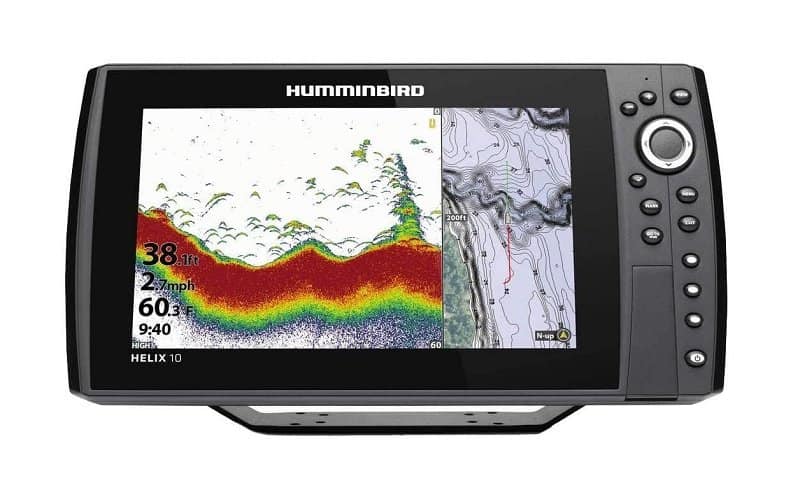
Humminbird HELIX 10 G3N Fish Finder
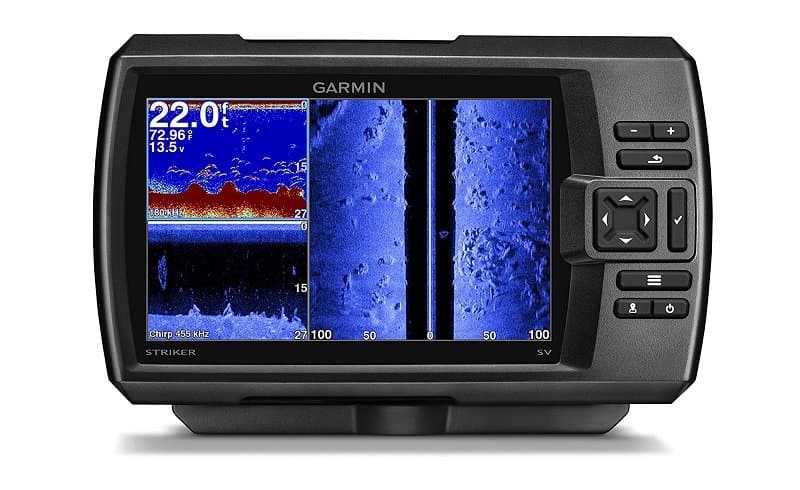
Garmin Striker 7
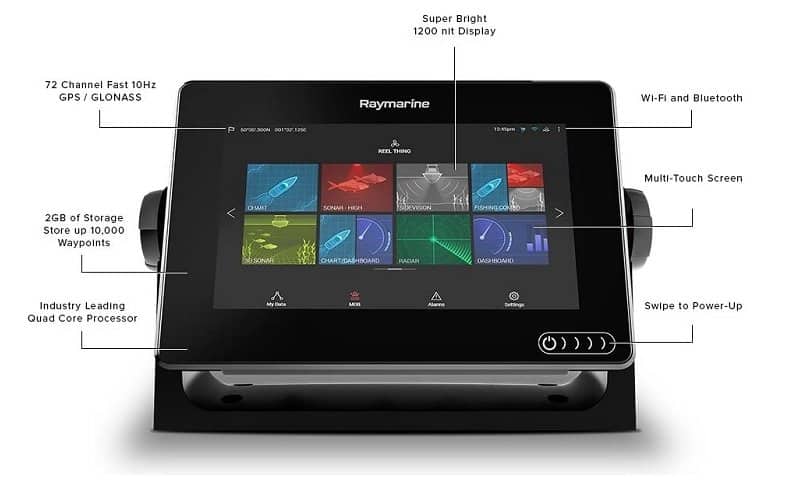
Raymarine Axiom 12
If you’re having trouble getting fish to bite then you might benefit from using a fish finder. While the idea of using technology to help land a catch might not be as romantic as the traditional image of a lone angler testing their patience in a battle of wits against an underwater foe, it certainly gets results.
With a dedicated fish finder installed onboard, you can seek out prime fishing spots, explore new areas, and spend more time catching fish, and less time wondering if there’s anything going on in the depths below.
Thanks to advances in sonar technology, even the smallest vessels can now use sonar transducers to help map out what’s going on under the water, with remarkable accuracy. However, in this article we’re going to be focused on permanent-mount fish finders—the kind you’ll find on larger boats or dedicated fishing vessels. If you’re looking for something smaller, cheaper, that sacrifices performance in favor of portability, we recommend you check out this article on the best portable fish finder devices instead.
To make sure that you buy the right fish finder for your needs, we’ve put together a list of the best fish finders on the market, with a short buying guide that explains what functions are on offer and what features you should be looking out for. Let’s get started!
Humminbird HELIX 10 G3N Fish Finder

Humminbird is one of the biggest names in the marine technology industry, with a large variety of quality products to their name. They offer a number of exciting fish finders but the HELIX series is undoubtedly the most popular.
The HELIX series is available in a number of screen sizes ranging from 5 inches to 12 inches, but we think that the HELIX 10 (named for the 10.1 inch display) offers the best mix of technology, screen clarity, and practicality of the bunch.
Apart from the large and accessible full-color TFT screen, the HELIX 10 G3N also features top of the range imaging technology, all controlled by an easy-to-use intuitive keypad. The most exciting of these features include dual spectrum CHIRP sonar, Humminbird Basemap, MEGA Side Imaging+ and MEGA Down Imaging+ sonar, and AutoChart Live mapping.
All in, the HELIX 10 can produce crystal clear imagine of what’s going on underwater, to depths of up to 200 ft. It can easily identify fish arches and fish holding structures and accurately pinpoint their location over wide areas.
Lastly, thanks to the module’s GPS technology and map features, it’s possible to use the fish finder as a navigation aid or use it to create detailed custom contour maps too.
The HELIX 10 comes equipped with a transducer as standard, and it’s also fully compatible with some Minn Kota trolling motors that come with built-in sonar too. A power cable, gimbal mounting bracket, all mounting hardware, and a cool unit cover are also included.
If you’re looking for a comprehensive fish finder that can do it all, and you’re not afraid of spending a little more money, then the Humminbird HELIX 10 G3N Fish Finder is what you need installed on your boat.
Pros
Screen Size: 10.1 inch (also available in 5, 7, 9 and 12 inch models)
Keypad: Raised button keypad
Transducer: Low-Q CHIRP transducer
GPS: Yes
Key Features: Intuitive fish finder with side and down imaging, and exceptional mapping technology
Garmin Striker 7

The Garmin Striker series of fish finders are top list mainstays. They come in a variety of sizes and configurations, with varying levels of ability. For our list, we rate the Garmin Striker 7SV as the best of the Garmin bunch.
This fish finder uses side-imaging technology that allows anglers to get a more concise view of what’s going on around the sides of their boat, rather than just directly below. If you’re looking for a fish finder that has a wider peripheral vision, then this is the one for you.
Built to withstand tough marine environments, the Striker 7 is waterproof up to IPX7 standards. The display unit it sturdy and built to last. The actual screen is a 7 inch LCD monitor that’s easy and clear to read, accompanied with a series of dedicated buttons for easy menu scrolling and option selection.
Garmin’s Striker 7 uses CHIRP sonar. The CHIRP function sends sonar pulses across a broad range of frequencies to collect a wide range of data. With this data, the Striker can produce more detailed maps, including accurate fish locations. It can use both side-view and down-view options for broader imaging.
Other features include a built-in flasher that allows you to view the sonar data in a different way, and a smart GPS function. The GPS connectivity can be used for much more than just pinpointing your location and logging your speed. You can also drop waypoint markers and pins to note your favorite fishing spots or particularly hazardous obstacles.
Each Garmin Striker 7SV ships with everything you need to use it right away, including a transducer and mounting instructions. Mounting is easy, and installation is a breeze. It’s a great product, and exceptional value for money.
Pros
Screen Size: 7 inch (also available in 3.5 and 5 inch models)
Keypad: Raised button keypad
Transducer: Included
GPS: Yes
Key Features: Side-view and down-view capabilities, with built in GPS
Raymarine Axiom 12

The Raymarine Axiom series is the top of the range when it comes to professional-grade fish finding technology. Raymarine’s Axiom 12 is the latest model of the range. It’s targeted towards serious anglers who want a comprehensive device that can do everything and do it well. As fish finders go, this one is a premium model with a premium price tag, and the number of features that this device packs more than justifies the large price tag.
The Axiom 12 is controlled by a 12 inch touchscreen interface that uses Ray Marine’s powerful Lighthouse 3 technology. In essence, it’s a powerful computer that gathers data from a number of sources to produce a clear image of exactly what’s going on under the water in real time.
The key ingredient to the Axiom 12’s success is the brand’s RealVision 3D 4 channel transom-mounted transducer. It uses gyroscopic technology that offsets the movement of the boat which helps to create clearer sonar image to floors up to 200 ft in depth. The RealVision 3D uses high-frequency CHIRP technology with CHIRP DownVIsion and SideVision sonar to produce high-definition, life-like marine imagery.
The Axiom series can also work with other included Ray Marine technologies, such as CHIRP sonar, Quantum radar, thermal imaging, audio integration, and more, to create one of the clearest underwater pictures available.
Other key features included GPS technology that can pinpoint a boat’s location with incredible accuracy, customizable charts and contour maps. In fact, the standard North America bundle comes preloaded with full coastal coverage for the US and Canada, with over 80,000 rivers, lakes, and inland waterways also covered. The device is also Wi-Fi and Bluetooth enabled, with full smartphone compatibility too.
If you’re in the market for a comprehensive fish finder with one of the most advanced transducers available, then the Raymarine Axiom is the perfect tool for the job.
Pros
Screen Size: 12 inch
Keypad: Touchscreen
Transducer: RealVision 3D RV-100
GPS: Yes
Key Features: RealVision 3D sonar, Navionics+, DownVision and SideVision technology
Humminbird HELIX 5
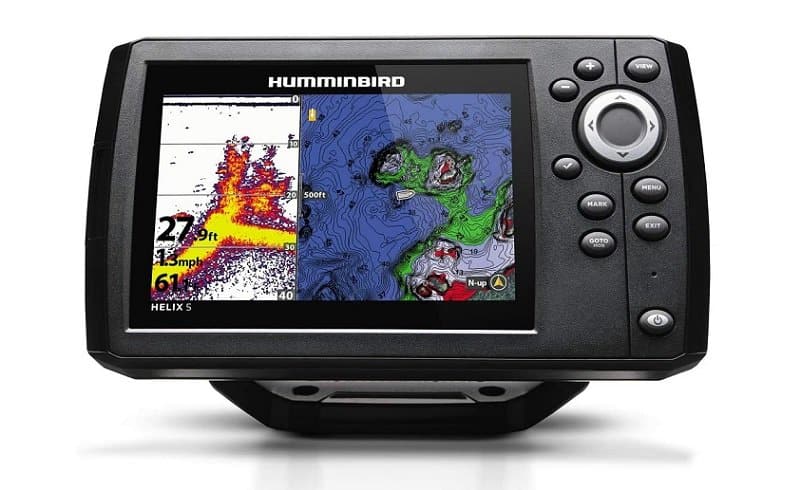
Lastly, we’re including another Humminbird product. This time, we’re looking at the Humminbird HELIX 5 G2. It shares a lot of DNA with the more advanced HELIX 10 model, but it has fewer features, a smaller screen, and a much smaller price tag. This could be one of the best fish finder tools for anglers on a budget.
This fish finder is a tough, waterproof unit that houses a wide 5 inch, color WVGA display. The menu can be navigated by using intuitive raised buttons, arranged in a comfortable, ergonomic pattern. The HELIX 5 uses Side and Down Imaging to give users an accurate representation of what’s going on under the water’s surface.
The advanced imagery is produced using a combination Humminbird’s smart 2D sonar and CHIRP technology. The CHIRP frequencies have a maximum depth of 1000 ft with wide angle coverage. By using two methods and covering the broadest range of frequencies possible, this fish finder can create more detailed maps, locating and identifying fish in the process.
The data is quickly evaluated by the device’s processor, with the results relayed in real time using AutoChart Live, Humminbird Basemap, and other cartography tools. Built-in GPS functions also allows the HELIX to act as a smart GPS device, using the latest maps and data from NOAA and LakeMaster to display accurate water and weather conditions. You can place way markers, note points of interest, and use the HELIX 5 for navigation purposes too.
In terms of power output and draw, the Humminbird HELIX 5 and an output of 500 Watts RMS, with a power draw of 615 mA.
Each HELIX 5 model ships with a transducer. For the GPS G2 model, a transom mounted XNT 9 20 T transducer comes as standard. Other extras include all the necessary mounting hardware, a power cable, and a gimbal mounting bracket.
Pros
Screen Size: 7 inch (though the Humminbird HELIX 7 is also a good choice)
Keypad: Raised buttons
Transducer: XNT 9 20 T Transom Transducer
GPS: Yes
Key Features: NOAA and LakeMaster charts, 2D and CHIRP sonar, with Side and Down View technology
Raymarine Dragonfly 7 Pro
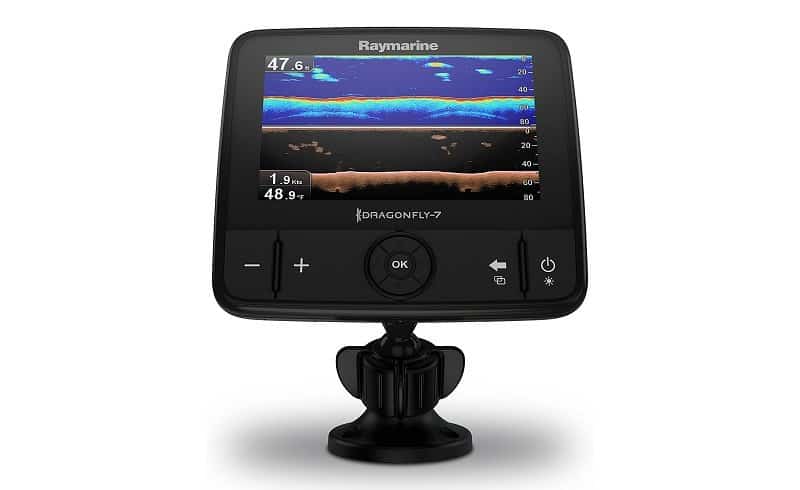
Next up we have a fish finder from Raymarine. Raymarine is one of the most well-established brands in the industry, bringing quality marine-related electronics to the market since 1923, when the company released their first echo depth sounder.
Technology has evolved considerably since then, and today’s modern fish finders use are far more advanced than those old depth sounders: the Raymarine Dragonfly 7 Pro is the perfect example of just how far we’ve come.
Controlled by a 7-inch wide HD LCD monitor, the Dragonfly Pro offers excellent underwater views in a sturdy weatherproof package. In fact, the monitor features optical bonding to prevent it fogging up, no matter what the weather conditions are. The rest of the package is tough and durable, and can handle severe weather with ease.
The display delivers excellent images of the underwater terrain to depths of up to 600 ft thanks to the use of CHIRP Spectrum sonar with Down Vision technology. The sonar can help pinpoint the location of fish and underwater structures with ease, and unparalleled accuracy.
Additionally, the Dragonfly Pro 7 is also a great GPS device. It comes equipped with Navionics charts and excellent map making features. Since it’s both GPS and Wi-Fi enabled, it updates all of the device’s bathymetric charts in real-time giving boaters up to date information. What’s more, the chartplotter function allows you to easily add waypoints and drop markers at your favorite fishing spots.
Each model ships with an advanced Dragonfly CPT-DVS transducer, a mounting plate, and all the necessary hardware. It’s easy to install, even easier to use, and excellent value for money. If you want an economically priced fish finder with advanced GPS technology and sophisticated mapping features, then this could be the device for you.
Pros
Screen Size: 7 inch (also available in 4 and 5 inch models)
Keypad: Easy touch button keypad
Transducer: Dragonfly CPT-DVS transom mount transducer
GPS: Yes
Key Features: Navionics maps of U.S and Canadian waters, Down View imaging, dual channel CHIRP sonar
Lowrance Elite 7X
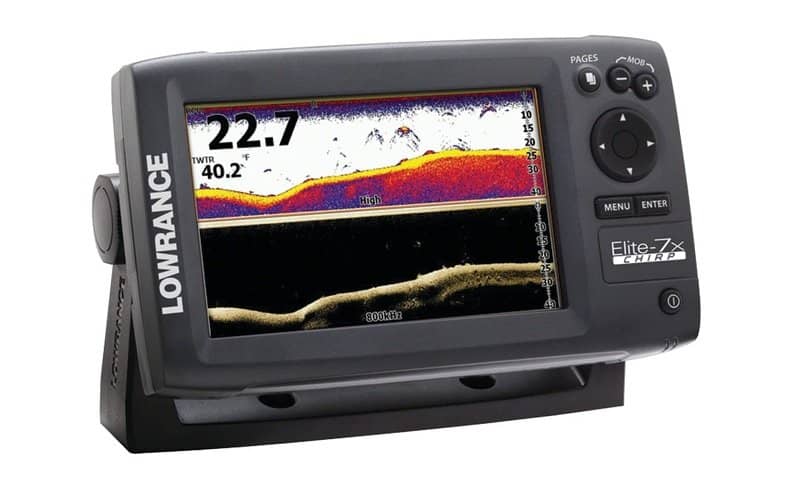
Lowrance is another well-established manufacturer of marine technology, and it’s one of the most popular brands out here. The brand’s Elite 7X fish finder is a moderately priced unit that offers a wide range of advanced features and some of the best imaging around. Unlike other fish finders on this list, the Elite 7X doesn’t have a GPS or chartplotting function: it’s purely for fish finding.
Equipped with a full-color 7-inch LCD screen, the Elite 7X is easy to read, and even easier to use. It has a simple button keypad that allows you to navigate the menu with ease. The screen offers a useful split-screen function that offers views of the underwater topography and a separate view of fish locations too.
The underwater imaging is created using Lowrance’s DownScan technology which can produce accurate scans of up to 300 ft in depth. Combined with Broadband CHIRP sonar (which offers maximum depths of 1,000 ft at the medium and high ranges) you can rely on receiving accurate and detailed pictures.
What’s more, Lowrance has equipped with Elite 7X with a number of operating modes to provide the best data for difference circumstances. For example, anglers can choose from modes such as Shallow Water, Fresh Water, Brackish Water, Deep Water, Slow Trolling, Fast Trolling, and more, to get the best pictures available.
It can also read water conditions, such as the water temperature, and it has an ice mode for ice fishing too. The Elite 7X has also been built to withstand anything the marine environment can throw at it, and it has an IPX7 waterproof rating too.
Finally, the Lowrance Elite 7X ships with everything you need to get started right away. Each unit comes with an 83/200KHz transducer, with a transom mount and mounting bracket, all installation hardware and an owner’s manual. It also comes with a full year warranty covering parts and labor.
Pros
Screen Size: 7 inches
Keypad: Easy touch button keypad
Transducer: 83/200KHz Lowrance transducer
GPS: No
Key Features: DownScan imaging, selectable user modes, CHIRP sonar, one year warranty
Lowrance Hook2 9
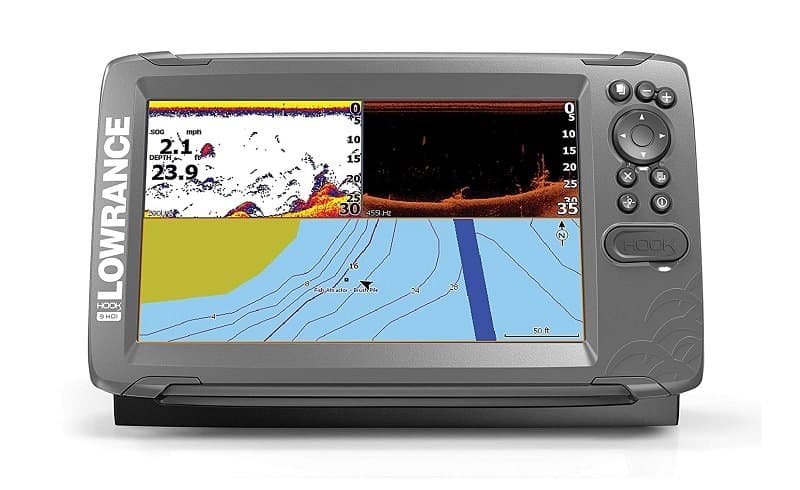
If you liked the sound of the Lowrance Elite 7X but want something a little bigger and with superior technology, then we recommend the Lowrance Hook2 9. It’s one of the best fish finder modules available. The asking price is a little more than for the Elite 7X but you get a load of extra goodies for the additional dollars.
Ideal for beginners and experienced anglers, the Lowrance Hook2 9 is user-friendly, easy to operate, and won’t let you down. This model is fitted in a broad 9 inch screen that can accurately display the underwater topography with crystal clear clarity. Menus can be navigated by a keypad, with no need for fiddly touch screen technology.
Imaging is produced using the Hook2’s DownScan, SideScan and CHIRP sonar to produce detailed views of fish patterns and the underwater situation to a depth of 80 meters. The sonar also features a very useful auto-tune function which automatically tunes the sonar to the situation, without you having to manually tune it in. This is what makes it a great beginner fish finder.
On top of that, the Hook2 features an impressive GPS system that can accurately pinpoint your location, with the ability to drop pins and waypoints on any of the device’s preloaded maps. Each unit ships with Navionics chart of inland and coastal waters from across the U.S and Canada.
This IPX7-rated fish finder comes with a SplitShot transducer and a one year manufacturer’s warranty as standard. Mounting the transducer may require a separate mounting plate, but that depends on the type of boat you own and where you plan to mount it. Apart from that, this unit has no negative points!
Pros
Screen Size: 9 inch (also available in 5 and 7 inch models)
Keypad: One touch raised button keypad
Transducer: SplitShot Transducer
GPS: Yes
Key Features: GPS-enabled fish finder with advanced sonar imaging, and a one year warranty
Fish Finder Buying Guide
Fish finders come in a wide variety of styles, with varying levels of ability and integrated features. Since there are so many different devices on the market, finding a product that’s right for you is no easy task. Before we get started with our buying guide, let’s take a quick look at what a fish finder is and how it works.
What Is A Fish Finder?
A fish finder is an electronic device that uses sonar technology to pinpoint the location of fish under the water’s surface. These devices consist of two key parts: a transducer that sends and receives signals underwater, and a screen that displays the data the transducer has collected. Modern fish finders do more than just locate fish though. They can also map underwater topography, calculate the water temperature, current, and depth, and search for sunken objects.
So, what features should you look out for when searching for the best fish finder?
Fish Finder Features To Look Out For
Considering that there are two major kinds of fish finders available on the market, portable or fixed mount, you should probably decide which kind suits your needs best before reading on. This guide for fixed, permanent-mounted devices. They’re generally far more expensive, larger, and packed with more features. Don’t discount portable ones, because they’re great! But this guide is for mounted models only. Here are the top things to keep in mind when you’re shopping around.
Device Size
Consider the size of your boat or kayak, and then make a quick evaluation of how much space you can spare for a fish finder. Most boat’s have limited space, and the last thing you want is a large device getting in your way, especially if you have to pull oars and position fishing rods in a tight area.
Luckily, fish finders are generally available in a wide range of sizes. These sizes have devices with screens that are a small as a few inches, right up to large 12” models. Bigger isn’t always better, but you also want to be able to read the information your fish finder displays. But before you can choose a screen you like, you have to make sure that the entire device can comfortably fit on your rig.
Display
Once you’ve got a size in mind, you can start exploring screen sizes and types. Since the screen displays all of the fish finder’s results, it’s important to have one that’s easy for you read. Larger screens may seem like the obvious best choice, but you should also look at the screen’s resolution too. The more pixels, the better. Unfortunately, more pixels and higher resolution means more money!
The type of display and how it displays information is also important too. Black and white displays do the job but they’re harder to read than full color displays. For the best results, we recommend searching for full color models since they’re easier to read in a wide range of weather conditions.
Transducer
Next, there’s the transducer. This is an important feature of any fish finder. It’s the part that broadcasts the sonar and receives the information. The transducer is what makes the difference between a quality fish finder and a poor one.
The more powerful a transducer is, the better quality of image you’ll receive. A stronger transducer can send sonar signals to greater depths, through rough conditions, and easily differentiate between fish patterns and other underwater obstacles.
We’ll cover transducer mounts a little further down, but before we get to that, we should talk a bit about transducer frequencies, cone angles, and view types.
Frequencies & View Types
Sonar operates on different frequencies. Getting the right frequency range for your needs is key to easy fish finding. In general, the higher the frequency, the higher the details. High frequency fish finders can generate the best images in shallower waters and from moving boats. They’re not so great in deep water.
Lower frequency fish finders offer superior depth penetration. They can get a better picture of deeper waters, but they don’t produce detailed images.
For shallow waters, frequencies between 200kHZ and 800kHZ are ideal.
For deeper waters, 50kHZ and 80kHZ work well.
There’s no perfect frequency, and most fish finders operate across a broad range. CHIRP broadband sonar, aka Compressed High Intensity Radar Pulse, transmits on dual frequencies to generate crisper underwater imagery with high levels of detail. CHIRP devices are more expensive to buy though.
A transducer’s cone angle directly relates to the frequency that it operates on and how broad or deep coverage it can receive. These days, modern fish finders have other technologies that help them generate wider, clearer, and deeper viewing angles. Here are the most popular types:
Side Scan
Side scan, as the name implies, uses a scanning sonar to cover a greater area around your boat. It can accurately give a broad view of what’s going on across large bodies of water, but it only works well in shallower, calmer water.
Down Scan
Down scan offers detailed views of what’s going on directly underneath your watercraft, but only in deeper waters. In shallow waters, the sonar can create garbled images. In deeper waters, it’s possible to locate and identify individual fish!
Using a combination of these two features allows for easy fish finding in a variety of conditions.
Transducer Mount Types
Back to transducers and how to mount them: this part is quite important since some transducers require a little bit of effort to install. The most popular transducer mounting types are transom-mount, thru-hull mount, in-hull mount, and trolling motor mounted transducers. Here’s a quick overview of the different types:
Transom-Mount
As the name implies, these transducers are mounted to the transom section of your boat, hanging from the stern into the water below the hull. These are very easy to install and the most common type of transducer mount for fish finders.
Thru-Hull Mount
Thru-hull mounts go directly through your boat’s hull. Fitting them can be tricky and they’re not suited to all boat types. If you’re not up to the challenge of drilling through your boat’s hull, leave this kind alone. However, they do produce the best quality signals.
In-Hull Mount
This kind of mount remains on the inside of your boat. It’s usually mounted to the inside of your boat’s hull and fixed firmly in place with a glue. The signal can be broadcast directly through the hull, not requiring direct water contact to operate.
Trolling Motor Mount
Trolling motor-mounted transducers are very popular. These transducers are located within the shaft of a trolling motor. Some trolling motors are specifically designed for fish finding purposes, making them great additions to any small fishing boat or inflatable fishing kayak.
Depending on what kind of boat you use, you may benefit from one type of mount over another. For example, inflatable boats or small kayaks won’t be compatible with thru-hull transducers. Similarly, boats that are regularly winched onto a trailer and transported out of the water may not benefit from a thru-hull or transom-mounted transducer. Having delicate instrumentation in exposed areas of the boat’s hull can put them in danger.
Take into account the size and shape of your boat, and how you transport it before investing in a transducer with a mount that might be incompatible with your vessel.
GPS
Another feature that’s becoming more and more common on fish finders is integrated GPS. While having GPS isn’t mandatory, it can be very useful. Being able to pinpoint your location is helpful in an emergency situation. Similarly, being able to mark your location on a map can make finding your favorite fishing spots much easier.
GPS is an excellent addition, but it does make a fish finder more expensive.
Integrated Maps
Like GPS, maps can really enhance a fishing trip. Fortunately, most modern fish finders come with detailed maps and chart preinstalled. Most devices with GPS and map capability will come equipped with maps of the US and Canada’s coastal and inland waterways. However, the level of detail and what bodies of water covered can vary dramatically depending on what package comes installed.
Water Type
There are a number of other things to consider before committing to a purchase, but these are less important. Still, if you want to guarantee that you’re buying the best product for your needs, it’s worth reading up if the type of water you’re fishing in will influence your purchase.
Anglers fishing in saltwater may have different requirements to those fishing in freshwater. Saltwater environments are harsher, and there’s generally more going on under the water’s surface, so you need a fish finder that’s tough enough to withstand the conditions but also powerful enough to produce clear imagery. Finders that work well in saltwater are generally more expensive.
Freshwater is easier on fish finders. Luckily, most manufacturers are aware that consumers need versatility, and there are devices that can work well in both salt and freshwater. However, you may need to tune your frequencies manually to get the best results.
In Summary: What Is The Best Fish Finder?
A fish finder is only going to provide the best results if it’s the right unit for you. By you, we mean your boat type, the water conditions that you’re fishing in, the kind of fish that you’re trying to catch, and your personal fishing preferences. What works for one angler may not work for another. The best way to find the best product for your needs is to do a bit of research before pulling the trigger on a new purchase.
However, if we were to pick three standout products that appeal to buyers with different budgets, then we’re recommend these three the most:
For those on a budget, we think the best fish finder at the lower end of the price spectrum would have to be the Garmin Striker 7. It offers an excellent range of features in a compact and easy-to-use package. It has GPS functions, both Side and Down View capabilities, and it comes with a powerful transducer too. However, if you want to spend a little less, then the Humminbird HELIX 5 is also a worthy budget contender.
If you’ve got deeper pockets and a budget that can stretch to the premium end of the market, then we’d recommend the Raymarine Axiom 12. This is an expensive unit, and there’s no escaping that fact. However, you get a lot of fish finding technology for your money. It boasts some of the most advanced underwater imaging technology available, pre-loaded with detailed maps of North America’s coastal and inland waterways, and much, much more. If you’re a professional angler or if you take your fishing very seriously, you should consider investing in this device.
Lastly, if you’re looking for a fish finder that offers the best of both worlds, with a full list of top-of-the-line features but at a more appropriate price tag, then we’d have to recommend the Humminbird HELIX 10 G3N Fish Finder. Like the Humminbird HELIX 7 or 5 models, the HELIX 10 offers smart imaging technology, built in maps, advanced GPS, and an intuitive operating interface, all for a price that won’t completely bankrupt you in the process.
Categories: Reviews
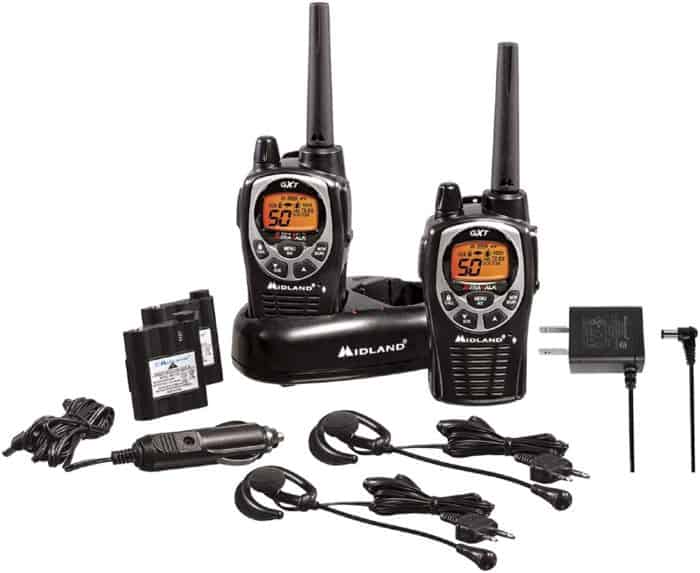


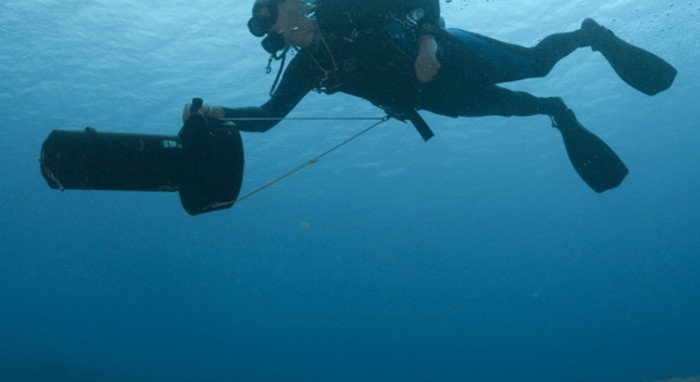








2 Comments
JimBob Newsome on August 25, 2021
Not a comment but a concern. I’m looking for a new Helix 5. I’m an old man wanting to see what’s going on under my 16’Jon boat. I never fish in waters over 25′. I don’t understand all this I read. All I want is a color screen. Able to see what’s under me. A GPS to find all the beds I’ve put out. My 525 laid down on me. It’s time for a new one. Can you hep me. Thanks
Steve Osborn on March 5, 2022
I am surprised that in this day of high tech, I don’t see a system that mounts on fishing deck for assistance in locating structure and fish, and also provides wireless connection from the fishing deck unit to a dash mounted unit exclusively for showing the boat driver the depth of the water while traveling at higher speeds when moving from one spot to another.